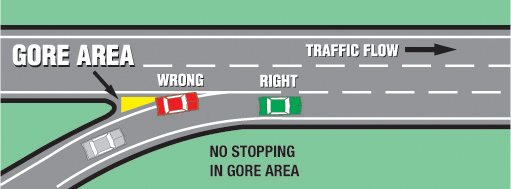The high speeds of highways in Arizona and the density of traffic on them require a special set of operating rules.
First, there are forbidden actions. There is NO STOPPING on a freeway. This includes the roadway itself, the shoulder, the off and on-ramps, and the median—anywhere on freeway right-of-way. Emergency stops are permitted, but you must take extra care. The shoulder of a busy freeway is a very dangerous place. If you leave an unattended vehicle along a busy freeway, you can expect it to be towed by the authorities pretty quickly. If you are approaching a vehicle stopped along a freeway, or a pedestrian, PLEASE change lanes to the left as you pass by. Arizona’s “Move Over” law requires motorists to move over one lane — or slow down if it is not safe to change lanes — when driving by any vehicle with flashing lights pulled to the side of a road or highway.. Imagine yourself standing beside the freeway, with traffic less than 3 feet away passing you at 75 mph. Please give them a WIDE berth, for their safety.
It is illegal to back up on a freeway, and you may not cross a median. If you miss a ramp or need to go back for some reason, you have no choice but to proceed to the next exit and then double back. Crossover roads are for official use and emergency vehicles only. Using a crossover to turn back is an extremely dangerous move, because you must enter the high speed traffic in the left lane.
A properly designed freeway on-ramp gives you the space to gain freeway speed before entering the traffic flow. Do not be tentative about accelerating to highway speed—the most significant danger is that caused by disparate vehicle speeds. Do not drive to the end of the ramp and slow to a crawl or stop while waiting for a “break” in traffic. If you accelerate to a proper merge speed, you can merge safely, and the existing traffic will be more likely to accommodate your entry. Traffic merging onto a freeway must yield to traffic already on it, but at the same time, competent, courteous drivers will make room for others to merge. Be careful to always make a visual head-check (not just mirrors!) before changing lanes or merging.
Be aware that it is often illegal to cross a freeway “gore area.” This is the triangular-shaped zone formed by the single or double white lines of an on or off-ramp as it connects with the through traffic lanes. In some states, signage prohibits crossing a gore area, in others special striping is used (double parallel white lines). In these states, you MUST use the lane until it ends; the end marks the beginning of the merging area. Understand that it is NOT illegal to cross a single, solid white line—only when they are doubled is crossing them a prohibited act (unless posted otherwise). These are federal rules, adopted by most states.
Generally, the right lane of a freeway is for entering and exiting the traffic flow. It’s a “staging” lane, for use at the beginning and end of your freeway “run.” The middle lanes are for through traffic, and the left lane is for passing. If you are not passing someone, you should not be driving in the left lane. Likewise, unless you are driving at a slower speed or preparing to enter or exit, you should move out of the right lane (this applies to a roadway with more than two lanes, of course).
If you encounter an emergency vehicle on a freeway, you should move to the right as much as necessary to let it pass you on the left. You are not expected to pull right and stop as you would on other roads—doing so would be dangerous. Keep in mind that emergency vehicle drivers are trained NOT to pass you on the right, so it’s important for you to move that direction to allow them safe passage on your left.
Finally, drive at a safe speed. Excessive speeding (more than 10 mph faster than traffic flow) or traveling too slowly increases the dangers and difficulty for all. If you view the traffic on a freeway as a giant, single organism, then it becomes apparent that it is the exceptions and differences, especially in speeds, that cause problems. The freeway is one driving arena where it is important to “blend.”
Keep the shiny side up!

